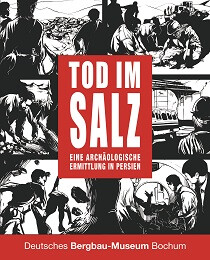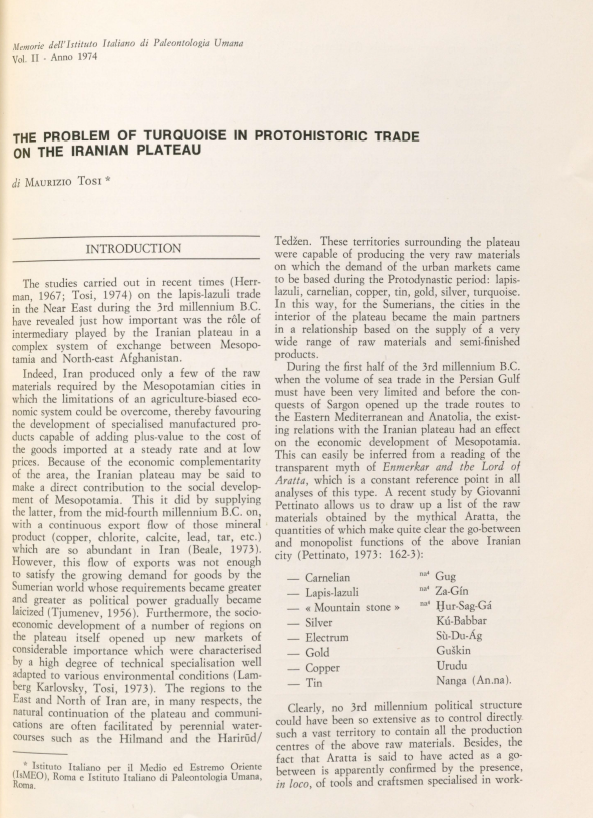Publications so far
0
| 1. |  | Stöllner, Thomas: Entangled Connections: Materialized Practices of Knowledge-Networks of Mining: From the Theoretical Level to its Empirical Consequences in Mining Archaeology.. In: Farrenkopf, Michael; Siemer, Stefan (Ed.): Materielle Kulturen des Bergbaus – Material Cultures of Mining: Zugänge, Aspekte und Beispiele – Approaches, Aspects and Examples, pp. 317-344, De Gruyter Oldenbourg, Berlin and Boston, 2022. (Type: Book Chapter | Links | BibTeX)@inbook{nokey, |
| 2. |  | Stöllner, Thomas; Aali, Abolfazl: Long-Term Salt Mining in Chehrābād: Resilient Strategies in Accessing Mineral Resources at the Iranian Highlands. In: Pearls, Politics and Pistachios: Essays in Anthropology and Memories on the Occasion of Susan Pollock’s 65th Birthday, pp. 352-369, Ex Oriente/Propylaeum, Berlin/Heidelberg, 2021. (Type: Book Chapter | Links | BibTeX)@inbook{nokey, |
| 3. |  | Stöllner, Thomas; Aali, Abolfazl; Kashani, Natascha Bagherpour (Ed.): Tod im Salz. Eine archäologische Ermittlung in Persien. Nünnerich-Asmus Verlag & Media GmbH, 2020, ISBN: 978-3-96176-141-8. (Type: Book | Abstract | Links | BibTeX)@book{nokey,Since the first discoveries in 1993 bodies or body-parts of eight humans have been discovered at the salt-mine of Douzlākh at Chehrābād. These bodies allow a reconstruction of their lives as workers during the different operation periods. By involving many different scientific fields, it became possible to investigate their palaeo-medical aspects, their diet and their health status as well the causes of their death and their involvement into different aspects of the mining operation and logistics of the mine. It is possible not only to reconstruct three different catastrophes during the Achaemenid, the early and the late Sasanian times but also to understand the social aspects of the working people. The Achaemenid miners certainly came from abroad but already stayed a while in the region, apart from the young miner no. 4 who seems to have arrived shortly before the catastrophe. This group of migrants possibly were sent within a “bandaka”, an Achaemenid labour duty. The Sassanian miners partly came from a “regional” background but also came shortly before their deaths. Saltman 1 is interesting as he is an older individual who possibly had a special role within the miners. Mining at Douzlakh was predominantly operated in periods of strong centralized political systems when governmental activities could be organized over longer distances. |
| 4. | Collon, Dominique: Lapis Lazuli from the East: A stamp seal in the British Museum. In: Ancient Civilizations from Scythia to Siberia, iss. 5, no. 3, pp. 31-39, 1999. (Type: Journal Article | Abstract | Links | BibTeX)@article{nokey,The article deals with the interpretation of two images on the lapis lazuli stamp seal from the Western Asiatic Department of Antiquities in the British Museum. The author compares the images with scenes on Shahdad "standard", on bifacial disc from eastern Iran and on fragments of steatite vases from Louvre and the British Museum, and comes to the conclusion that the figure with a sidelock is a male personage, the other one is a female. Links with the art of south-eastern Iran put the stamp seal in the context of the Trans-Elamite culture, about 2550-2250 B.C. | |
| 5. | Casanova, Michele: The Sources of the Lapis Lazuli Found in Iran. In: South Asian archaeology 1989 : papers from the Tenth International Conference of South Asian Archaeologists in Western Europe, Musée National des Arts Asiatiques - Guimet, Paris, France, 3-7 July, 1989
, pp. 49-56, Prehistory Press, 1992. (Type: Book Chapter | BibTeX)@inbook{nokey, | |
| 6. | Besenval, R.: Les populations nomades et l'exploitation des ressources minerales dans les zones arides et semi-arides. In: Nomades et Sedentaires en Asie Cantrale. Apports de l'archeologie et de l'ethnologie
, pp. 53-56, CNRS Éditions, 1990. (Type: Book Chapter | BibTeX)@inbook{nokey, | |
| 7. |  | Tosi, Maurizio: The problem of turqoise in protohistoric trade on the Iranian Plateau. In: Memrie Dell'Instituto di Paleontologia Umana, vol. II, pp. 147-162, 1974. (Type: Journal Article | BibTeX)@article{nokey, |
| 8. | Holzer, Herwig F.: Über Kupfererzvorkommen im Bergland von Qom, westlicher Zentral-Iran. In: Festschrift Otmar Michael Friedrich zur Vollendung des 70. Lebensjahres und zur Emeritierung
, pp. 141-146, Inst. f. Mineralogie u. Gesteinskunde d. Montanist. Hochschule Leoben, 1974. (Type: Book Chapter | BibTeX)@inbook{nokey, | |
| 9. | Shafighi, C.: Die Erzvorkommen im Gebiet von Ahangaran (b. Malayer, Iran). 1973. (Type: PhD Thesis | BibTeX)@phdthesis{nokey, |
2022 |
|
 | Stöllner, Thomas: Entangled Connections: Materialized Practices of Knowledge-Networks of Mining: From the Theoretical Level to its Empirical Consequences in Mining Archaeology.. In: Farrenkopf, Michael; Siemer, Stefan (Ed.): Materielle Kulturen des Bergbaus – Material Cultures of Mining: Zugänge, Aspekte und Beispiele – Approaches, Aspects and Examples, pp. 317-344, De Gruyter Oldenbourg, Berlin and Boston, 2022. (Type: Book Chapter | Links | BibTeX | Tags: Minerals, Mining, Resources, Social, social relations)@inbook{nokey, |
2021 |
|
 | Stöllner, Thomas; Aali, Abolfazl: Long-Term Salt Mining in Chehrābād: Resilient Strategies in Accessing Mineral Resources at the Iranian Highlands. In: Pearls, Politics and Pistachios: Essays in Anthropology and Memories on the Occasion of Susan Pollock’s 65th Birthday, pp. 352-369, Ex Oriente/Propylaeum, Berlin/Heidelberg, 2021. (Type: Book Chapter | Links | BibTeX | Tags: Achaemenid, Administration, Bronze Age, Chalcolithic, Institutions, Iron Age, Islamic era, Minerals, Mining, Neolithic, Resilience, Resources, Salt, Sasanian, Zanjan)@inbook{nokey, |
2020 |
|
 | Stöllner, Thomas; Aali, Abolfazl; Kashani, Natascha Bagherpour (Ed.): Tod im Salz. Eine archäologische Ermittlung in Persien. Nünnerich-Asmus Verlag & Media GmbH, 2020, ISBN: 978-3-96176-141-8. (Type: Book | Abstract | Links | BibTeX | Tags: Achaemenid, Administration, Bronze Age, Chalcolithic, Institutions, Iron Age, Islamic era, Minerals, Mining, Mobility, Neolithic, Salt, Sasanian, Zanjan)@book{nokey,Since the first discoveries in 1993 bodies or body-parts of eight humans have been discovered at the salt-mine of Douzlākh at Chehrābād. These bodies allow a reconstruction of their lives as workers during the different operation periods. By involving many different scientific fields, it became possible to investigate their palaeo-medical aspects, their diet and their health status as well the causes of their death and their involvement into different aspects of the mining operation and logistics of the mine. It is possible not only to reconstruct three different catastrophes during the Achaemenid, the early and the late Sasanian times but also to understand the social aspects of the working people. The Achaemenid miners certainly came from abroad but already stayed a while in the region, apart from the young miner no. 4 who seems to have arrived shortly before the catastrophe. This group of migrants possibly were sent within a “bandaka”, an Achaemenid labour duty. The Sassanian miners partly came from a “regional” background but also came shortly before their deaths. Saltman 1 is interesting as he is an older individual who possibly had a special role within the miners. Mining at Douzlakh was predominantly operated in periods of strong centralized political systems when governmental activities could be organized over longer distances. |
1999 |
|
Collon, Dominique: Lapis Lazuli from the East: A stamp seal in the British Museum. In: Ancient Civilizations from Scythia to Siberia, iss. 5, no. 3, pp. 31-39, 1999. (Type: Journal Article | Abstract | Links | BibTeX | Tags: Minerals, Seals)@article{nokey,The article deals with the interpretation of two images on the lapis lazuli stamp seal from the Western Asiatic Department of Antiquities in the British Museum. The author compares the images with scenes on Shahdad "standard", on bifacial disc from eastern Iran and on fragments of steatite vases from Louvre and the British Museum, and comes to the conclusion that the figure with a sidelock is a male personage, the other one is a female. Links with the art of south-eastern Iran put the stamp seal in the context of the Trans-Elamite culture, about 2550-2250 B.C. | |
1992 |
|
Casanova, Michele: The Sources of the Lapis Lazuli Found in Iran. In: South Asian archaeology 1989 : papers from the Tenth International Conference of South Asian Archaeologists in Western Europe, Musée National des Arts Asiatiques - Guimet, Paris, France, 3-7 July, 1989
, pp. 49-56, Prehistory Press, 1992. (Type: Book Chapter | BibTeX | Tags: Minerals, Resources)@inbook{nokey, | |
1990 |
|
Besenval, R.: Les populations nomades et l'exploitation des ressources minerales dans les zones arides et semi-arides. In: Nomades et Sedentaires en Asie Cantrale. Apports de l'archeologie et de l'ethnologie
, pp. 53-56, CNRS Éditions, 1990. (Type: Book Chapter | BibTeX | Tags: Minerals, Resources)@inbook{nokey, | |
1974 |
|
 | Tosi, Maurizio: The problem of turqoise in protohistoric trade on the Iranian Plateau. In: Memrie Dell'Instituto di Paleontologia Umana, vol. II, pp. 147-162, 1974. (Type: Journal Article | BibTeX | Tags: Minerals, Trade)@article{nokey, |
Holzer, Herwig F.: Über Kupfererzvorkommen im Bergland von Qom, westlicher Zentral-Iran. In: Festschrift Otmar Michael Friedrich zur Vollendung des 70. Lebensjahres und zur Emeritierung
, pp. 141-146, Inst. f. Mineralogie u. Gesteinskunde d. Montanist. Hochschule Leoben, 1974. (Type: Book Chapter | BibTeX | Tags: Metal Resources, Minerals)@inbook{nokey, | |
1973 |
|
Shafighi, C.: Die Erzvorkommen im Gebiet von Ahangaran (b. Malayer, Iran). 1973. (Type: PhD Thesis | BibTeX | Tags: Metal Resources, Minerals, Resources)@phdthesis{nokey, | |
